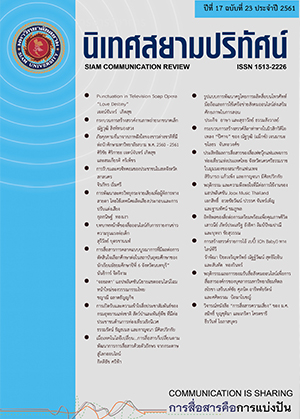Behaviors and Acceptance of Social Media for Organizational Communication by Personnel at Mahidol University
Main Article Content
Abstract
In this thesis, the researcher studies (1) behaviors in the use of social media by organizational personnel at Mahidol University; (2) the exposure of social media by these personnel; and (3) their acceptance of social media. The research population for this quantitative research investigation consisted of 33,454 Mahidol University personnel in the three areas of Bangkok Noi, Phaya Thai and Salaya. The sample size of 400 subjects was based on an extrapolation from the Taro Yamané formula. The instrument of research for gathering data was a questionnaire. Using techniques of descriptive statistics, the researcher analyzed the data collected in terms of frequency (f), percentage (%), mean (M) and standard deviation (SD). The chi-square (χ2) method, a t test technique and one-way analysis of variance (ANOVA) were utilized in hypothesis testing. When relationships between two variables were under consideration, Cramer’s V method was used as a measurement of the strength of the statistical relationship in question. Statistical significance was set at the .05 level. Findings are as follows: The highest proportion of the sample population was located at Bangkok Noi. They were males between the ages of thirty and forty. They were university employees falling under the category of academic support personnel. They utilized the Internet network in the WIFI type at the highest level. Their social media status fell under the rubrics of presenters, readers, and followers. They were both message receivers and senders. In regard to the behaviors of using social media of these Mahidol University personnel, the following was found: The largest proportion used Line at the highest level. They had an exposure to social media for all factors at a high level. These factors were individual needs; social factors; social media contents; characteristics of social media; and equipment. In regard to the acceptance of social media at their university, the following was found: University personnel knew and had the perception that social media were used in intra-organizational communication at Mahidol University. The highest proportion perceived that Facebook was used in intra-organizational communication. They knew of channels, methods of access to the use of social media and information for use from the university website at the highest level. University personnel who were not cognizant of the use of social media in intra-organizational communication at the university recommended that the university should present information concerning the use of social media via the university website and Intranet as the most convenient means of disseminating this information. The motivating factor that made these personnel accept the use of social media in intra-organizational communication was that they knew that the university had a policy to use social media. They decided to accept this policy because utilizing social media was beneficial for their work at the university. They accepted using social media at work because they knew the means whereby social media could be utilized.
Article Details
References
ธาริณี นาคเมธี. (2557). พฤติกรรมการสื่อสารภายในองค์กรของบุคลากรในหน่วยงานราชการ เขตอำเภอเมือง จังหวัดพิษณุโลกผ่านการใช้แอพพลิเคชั่นไลน์ (LINE). วิทยานิพนธ์ปริญญามหาบัณฑิต, มหาวิทยาลัยนเรศวร.
พรทิพย์ กิมสกุล. (2553). พฤติกรรมการใช้ยูทูบและประเด็นจริยธรรมทางข้อมูลข่าวสารของผู้ใช้ยูทูบในประเทศไทย. วิทยานิพนธ์ปริญญามหาบัณฑิต, จุฬาลงกรณ์มหาวิทยาลัย.
พิชิต วิจิตรบุญยรักษ์. (2554). สื่อสังคมออนไลน์: สื่อแห่งอนาคต. วารสารนักบริหาร มหาวิทยาลัยกรุงเทพ, 31(4), 103.
Rogers, E. M. (1995). Diffusion of Innovation. New York: Free Press.
กองทรัพยากรบุคคล มหาวิทยาลัยมหิดล. (2559). ข้อมูลสารสนเทศบุคลากร มหาวิทยาลัยมหิดล. เข้าถึงได้จาก http://intranet.mahidol/op/orpr/newhrsite/AboutHR/stat2559/Stat.php
กองบริหารงานทั่วไป มหาวิทยาลัยมหิดล. (ม.ป.ป.). ภารกิจงานสื่อสารองค์กร (Corporate Communications Unit). เข้าถึงได้จาก http://www.op.mahidol.ac.th/orga/th/ unit-cc/index.html
ปณิชา นิติพรมงคล. (2555). พฤติกรรมการใช้เครือข่ายสังคมออนไลน์ของคนวัยทำงานในเขตกรุงเทพมหานคร. เข้าถึงได้จาก http://www.spu.ac.th/commarts/files/2012/07/บทความ-ปณิชา.pdf


